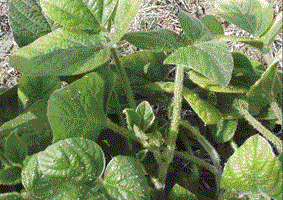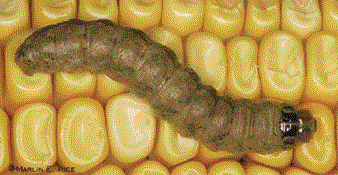Insect Management Redux
 |
Kevin L. SteffeyProfessor and Extension Specialist in EntomologyPhone: (217) 333-6652 E-mail: ksteffey@illinois.edu |
 |
Michael E. GrayProfessor and Extension Specialist in EntomologyPhone: (217) 333-6652 E-mail: megray@illinois.edu |
|
The title of this paper reflects a "bringing back" (definition of redux–brought back) or a renewed discussion of integrated pest management (IPM), broadly speaking, and insect management more specifically. Within the past few years, the never-ending pursuits of higher yields and higher profits (neither inherently bad pursuits) and competition among agricultural input suppliers (also not a bad thing) have resulted in insect management (or, more accurately, control) practices that do not always abide the principles of IPM. So, this discussion will focus upon the original principles of IPM, current and emerging issues in field crop insect management, and concerns about some current or pending insect control practices. The discussion is not intended to renounce all of the examples provided, but rather to direct attention to the possible consequences of unbridled insect control activities.
Integrated Pest Management (IPM)
In his book Entomology and Pest Management (1999, third edition), Dr. Larry P. Pedigo (retired entomologist, Iowa State University) said it best: "Probably as many definitions of pest management have been suggested as there are authors on the topic." However, he and other authors almost always define IPM with three elements: (1) multiple tactics used in a compatible manner; (2) pest populations maintained below levels that cause economic damage; and (3) conservation of environmental quality. We simplify these elements by focusing on three Es-economics, ecology, and environment. All three of these aspects of a pest management program should be considered before a producer implements pest control tactics. Unfortunately, over the past decade or so, ecology and the environment have taken a back seat to economics, or at least to spending money to control insects. A colleague once told me, "It seems as if spending money has become synonymous with best management practices."
Economics
No producer elects to spend money on insect control knowing that he or she will lose money. However, many producers never know whether money spent on insect control is money well spent, i.e., there is some return on investment. The use of an insecticide "just in case" may represent an economic loss if the insect never shows or occurs at densities below the economic injury level (simply put, cost of control = cost of insect damage). This concept was discussed well before concerns about environmental quality arose in the late 1950s and early 1960s. In 1934, W. D. Pierce (Entomological News 45: 1- 4) asked, "Is all insect attack to be computed as assessable damage? If not, at what point does it become assessable? Is control work warranted when damage is below that point?" More routine use of untreated checks would go a long way toward answering these questions outside the halls of academia.
Ecological Backlash
After the obvious importance of economics, the importance of environmental quality associated with insect management has been addressed most often (e.g., effects of chemical insecticides on fish and birds and in groundwater). However, one could argue that the biggest concern associated with modern insect control practices is ecological backlash, another term used by Pedigo. As he defines it, "ecological backlash involves the counter-responses of pest populations or other biotic factors in the environment that diminish the effectiveness of management tactics." Three Rs characterize this concern-resistance, resurgence, and replacement.
The advent of Bt corn for insect management has focused enormous attention on the possibility of the development of insect resistance if Bt corn is planted on millions of acres. Selection pressure of this magnitude (i.e., exposing a pest species to one or two toxic proteins throughout the Corn Belt) could easily result in the development of insect resistance to the protein(s). Consequently, the U.S. EPA requires that a non–Bt refuge must be planted with a Bt crop.
Unfortunately, resurgence and replacement have not been addressed as frequently. When an insect pest is controlled and its natural enemies are killed with it, populations of the pest may resurge in the absence of its natural enemies, sometimes to numbers greater than the numbers that occurred before control tactics were implemented. Replacement occurs when a major pest is suppressed and continues to be suppressed by a tactic but is replaced by another, previously minor pest. These repercussions of overuse or misuse of insect control technologies will be discussed in the examples in another section of this paper.
Current and Emerging Issues in Field Crop Insect Management
Current and emerging issues in field crop insect management early in the 21st Century are both reminiscent of and distinct from issues in the latter half of the 20th Century. For example, there is much current emphasis on invasive species; the discovery of the soybean aphid (Figure 1) in North America captured a lot of attention and marshaled considerable research and education efforts. However, invasive species have been a part of our pest management culture for decades. Alfalfa weevils, European corn borers, Japanese beetles, and western corn rootworms, among others, all are invasive species.
The changing status of some pests also seems like a new issue (e.g., secondary insect pests becoming more prevalent), but pest status changes constantly as farming practices change. And as in the past, distributions of some insect pests expand, bringing the threat of "new" insect pests into new areas-variant western corn rootworm, Japanese beetle, western bean cutworm.
But what makes the current and emerging issues in field crop insect management so distinct from past issues is the availability of new, and in some cases, radically different tools for insect management and the issues associated with these tools. In many ways, the introduction and widespread use of these tools are reminiscent of the allure of chlorinated hydrocarbon insecticides when they were introduced. The widespread use of chlorinated hydrocarbon insecticides achieved resounding successes in insect control, reducing the impact of many agricultural insect pests. However, as we all know, the widespread use of these insecticides and subsequent negative impacts also gave rise to the IPM concept. Consequently, we believe that the potential consequences of the overuse or misuse of new insect management tools deserve the same scrutiny.
Most notable among the new insect management tools are transgenic crops for insect control. The initial focus has been on Bt corn for control of two primary pests of corn–European corn borer and corn rootworms. The development of future transgenic crops for insect control will hinge, in part, on the success or failure of our current transgenic crops. Modern insecticidal seed treatments with systemic activity also are a new tool for insect management. With both of these new tools comes a renewed emphasis on concerns about insect resistance and disruption of ecological balance.
Examples of Insect Management "Solutions" To Real Problems
Negative experiences with insects and their management give rise to a multitude of "solutions," some of which reflect genuine frustration, and others of which are marketed to play upon the fears of insect-related yield losses. The implementation of some of these insect management solutions may have little or no negative consequences in the environment, resulting solely in unnecessary costs. On the other hand, some insect management solutions could have dire long-term consequences. A few real–world situations may help to emphasize this point.
Secondary Insect Pests and Their Control
Over the past several years, secondary insect pests of corn (e.g., grape colaspis, white grubs, wireworms) seem to have become more problematic. As this was occurring, nicotinoid insecticides were being developed as seed treatments for corn. Currently, two insecticidal seed treatments–Cruiser and Poncho–are being applied to millions of acres of corn, with expectations of even more widespread use in 2005. Both of these products are very closely related. Concomitantly, the development of nicotinoid insecticides as seed treatments for soybeans is underway. It is entirely plausible that one or a very few closely related active ingredients will be applied to multiple millions of crop acres in the near future. Yet, no insect resistance management plan for use of this technology is required, and the potential effects of such widespread use of nicotinoids on ecological balance have not been studied thoroughly.
The Soybean Aphid Outbreak of 2003
Because so many producers in Illinois experienced yield losses as a result of soybean aphid infestations in 2003, over-reaction was inevitable. Despite the fact that very low and non-economic densities of soybean aphids occurred in 2004, some producers sprayed insecticides for soybean aphid control anyway, simply to avoid "going down that road again." We addressed this issue in more than one article of the Bulletin in 2004, reminding producers that unnecessary insecticide application is costly and could result in resurgence of soybean aphids after insecticides were applied (because multicolored Asian lady beetles would be killed, too). Of even greater concern was the practice of applying a fungicide + an insecticide in mid-season, with promises of yield benefits, even in the absence of pest populations. Even if short-term yield benefits accrue from this practice (and data to support this claim are limited), what long-term prices are we willing to pay?
Corn Rootworm Management in 2004
Corn rootworms caused significant problems throughout the northern half of Illinois in 2004 (Figure 2). Soil insecticides and insecticidal seed treatments applied during the early planting season did not provide satisfactory protection against corn rootworm larvae in June and July. In addition, we and a few producers observed greater-than-expected rootworm larval damage to YieldGard Rootworm corn in 2004. The resulting articles in the Bulletin gave rise to a lot of rumors and some suggested "solutions" for rootworm control. Among the latter are:
- Increase the rate of application of soil insecticides.
- Treat the corn with both a soil insecticide and an insecticidal seed treatment-the soil insecticide for corn rootworms, the seed treatment for secondary insects.
- Grow YieldGard Rootworm corn, but also apply a soil insecticide. (And by the way, all YieldGard Rootworm corn is treated with a low rate of nicotinoid insecticide.)
- Apply insecticides to kill egg-laying female western corn rootworms in soybeans in late summer, then follow up with application of a soil insecticide, insecticidal seed treatment, or YieldGard Rootworm corn the following year.
All of these solutions to rootworm management challenges are bad ideas. Increasing rates of insecticide application never has and never will improve rootworm control. This response ultimately leads to bigger problems (e.g., resistance). Doubling up (or tripling up, in some frightful recommendations by some people) on rootworm control technologies is an invitation for disaster. All concerns about ecological backlash aside, the economics associated with such "solutions" make little sense.
Just because a product may not have provided satisfactory control of rootworm larvae during any given year does not mean that the product will fail to provide satisfactory control in all future years. Such could not be further from the truth. Throughout the modern history of rootworm management, all of the currently available products have failed to control rootworms adequately at some time under certain circumstances. Consider a product's consistency of performance over time and geography when considering the reliability of the product. Remember, none of these products are bullet–proof.
Western Bean Cutworm Moves Into Illinois
The western bean cutworm (Figure 3) has spread eastward relatively rapidly since its discovery in western Iowa only a few years ago. It is likely that this pest has made its way into Illinois; some adult western bean cutworms were captured in a trap in Henry County, Illinois, in mid–July 2004. Consequently, some producers may have to contend with the western bean cutworm in 2005. So, after so many years of being relatively confined in the western Corn Belt, why has this pest spread so quickly eastward? Although there is no proof yet, it is possible that the use of YieldGard Corn Borer hybrids has enabled this pest to spread. As we know, YieldGard Corn Borer hybrids are very effective against European corn borers and southwestern corn borers, and they provide some control of corn earworms. However, YieldGard Corn Borer hybrids do not control western bean cutworms effectively. It is possible that the western bean cutworm has filled the niche in YieldGard Corn Borer corn that has been vacated by the other caterpillars. This would represent a clear example of replacement.
Summary
We've all heard the saying that the more things change, the more things stay the same. The insects and their associated control technologies will change over time, but the underlying principles of insect management will not. We must be forever cognizant of the potential negative consequences of overuse or misuse of insectcontrol technologies and do everything we can to be good stewards of the old, new, and emerging technologies. We recommend development of insect management plans rather than responding to insect management challenges with a knee–jerk reaction. Some of the aforementioned short-term "solutions" will lead to long–term problems that will be very costly to everyone.
Tables & Figures
 |
Figure 1. Soybean
aphids were present but at low densities in 2004. (Photograph by Jim Morrison) |
 |
Figure 2. Corn rootworm larvae
caused significant damage, resulting in lodging, in 2004. (Photograph by Tony Sibert) |
 |
Figure 3. Western bean cutworm. (Photograph by Marlin Rice) |